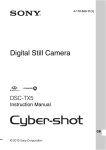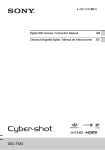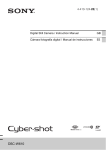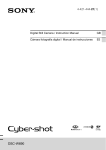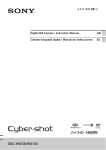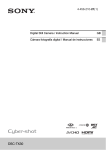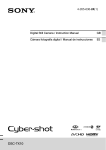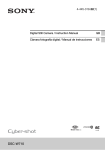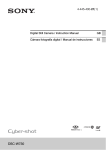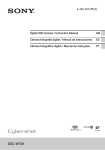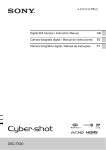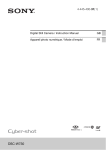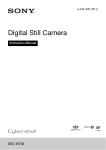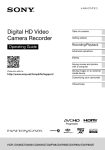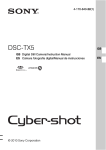Download Sony DSC-TF1/L Instruction Manual
Transcript
4-452-084-22(1) DSC-TF1 Digital Still Camera / Instruction Manual GB Cámara fotografía digital / Manual de instrucciones ES English Learning more about the camera (“Cyber-shot User Guide”) “Cyber-shot User Guide” is an on-line manual. Refer to it for in-depth instructions on the many functions of the camera. 1 Access the Sony support page. http://www.sony.net/SonyInfo/Support/ 2 Select your country or region. 3 Search for the model name of your camera within the support page. • Check the model name on the bottom of your camera. Checking the supplied items The number in parentheses indicates the number of pieces. • Camera (1) • Rechargeable battery pack NP-BN (1) (This rechargeable battery pack cannot be used with Cyber-shot that are supplied with the NP-BN1 battery pack.) • Dedicated USB cable (1) (Pan-International Industrial GP00621A-11) • AC Adaptor AC-UB10/UB10B/UB10C/UB10D (1) • Power cord (mains lead) (not supplied in the USA and Canada) (1) • Wrist strap (1) • Instruction Manual (this manual) (1) • Notes on the water-proofing (1) GB 2 Owner’s Record The model and serial numbers are located on the bottom. Record the serial number in the space provided below. Refer to these numbers whenever you call your Sony dealer regarding this product. Model No. DSC-TF1 Serial No. _____________________________ Model No. AC-UB10/AC-UB10B/AC-UB10C/AC-UB10D Serial No. _____________________________ GB WARNING To reduce fire or shock hazard, do not expose the unit to rain or moisture. IMPORTANT SAFETY INSTRUCTIONS -SAVE THESE INSTRUCTIONS DANGER TO REDUCE THE RISK OF FIRE OR ELECTRIC SHOCK, CAREFULLY FOLLOW THESE INSTRUCTIONS If the shape of the plug does not fit the power outlet, use an attachment plug adaptor of the proper configuration for the power outlet. CAUTION [ Battery pack If the battery pack is mishandled, the battery pack can burst, cause a fire or even chemical burns. Observe the following cautions. • Do not disassemble. • Do not crush and do not expose the battery pack to any shock or force such as hammering, dropping or stepping on it. • Do not short circuit and do not allow metal objects to come into contact with the battery terminals. • Do not expose to high temperature above 60°C (140°F) such as in direct sunlight or in a car parked in the sun. • Do not incinerate or dispose of in fire. • Do not handle damaged or leaking lithium ion batteries. GB 3 • Be sure to charge the battery pack using a genuine Sony battery charger or a device that can charge the battery pack. • Keep the battery pack out of the reach of small children. • Keep the battery pack dry. • Replace only with the same or equivalent type recommended by Sony. • Dispose of used battery packs promptly as described in the instructions. [ AC Adaptor Use the nearby wall outlet (wall socket) when using the AC Adaptor. Disconnect the AC Adaptor from the wall outlet (wall socket) immediately if any malfunction occurs while using the apparatus. For Customers in the U.S.A. and Canada [ RECYCLING LITHIUM-ION BATTERIES Lithium-Ion batteries are recyclable. You can help preserve our environment by returning your used rechargeable batteries to the collection and recycling location nearest you. For more information regarding recycling of rechargeable batteries, call toll free 1-800-822-8837, or visit http://www.rbrc.org/ Caution: Do not handle damaged or leaking Lithium-Ion batteries. [ Battery pack This device complies with Part 15 of the FCC Rules. Operation is subject to the following two conditions: (1) This device may not cause harmful interference, and (2) this device must accept any interference received, including interference that may cause undesired operation. This Class B digital apparatus complies with Canadian ICES-003. GB 4 For Customers in the U.S.A. UL is an internationally recognized safety organization. The UL Mark on the product means it has been UL Listed. If you have any questions about this product, you may call: Sony Customer Information Center 1-800-222-SONY (7669) The number below is for the FCC related matters only. GB [ Regulatory Information Declaration of Conformity Trade Name: SONY Model No.: DSC-TF1 Responsible Party: Sony Electronics Inc. Address: 16530 Via Esprillo, San Diego, CA 92127 U.S.A. Telephone No.: 858-942-2230 This device complies with Part15 of the FCC Rules. Operation is subject to the following two conditions: (1) This device may not cause harmful interference, and (2) this device must accept any interference received, including interference that may cause undesired operation. [ CAUTION You are cautioned that any changes or modifications not expressly approved in this manual could void your authority to operate this equipment. [ Note: This equipment has been tested and found to comply with the limits for a Class B digital device, pursuant to Part 15 of the FCC Rules. These limits are designed to provide reasonable protection against harmful interference in a residential installation. This equipment generates, uses, and can radiate radio frequency energy and, if not installed and used in accordance with the instructions, may cause harmful interference to radio communications. However, there is no guarantee that interference will not occur in a particular installation. If this equipment does cause harmful interference to radio or television reception, which can be determined by turning the equipment off and on, the user is encouraged to try to correct the interference by one or more of the following measures: – Reorient or relocate the receiving antenna. – Increase the separation between the equipment and receiver. – Connect the equipment into an outlet on a circuit different from that to which the receiver is connected. – Consult the dealer or an experienced radio/TV technician for help. GB 5 The supplied interface cable must be used with the equipment in order to comply with the limits for a digital device pursuant to Subpart B of Part 15 of FCC Rules. For Customers in Europe [ Notice for the customers in the countries applying EU Directives This product has been manufactured by or on behalf of Sony Corporation, 1-7-1 Konan Minato-ku Tokyo, 108-0075 Japan. Inquiries related to product compliance based on European Union legislation shall be addressed to the authorized representative, Sony Deutschland GmbH, Hedelfinger Strasse 61, 70327 Stuttgart, Germany. For any service or guarantee matters, please refer to the addresses provided in the separate service or guarantee documents. This product has been tested and found compliant with the limits set out in the EMC regulation for using connection cables shorter than 3 meters (9.8 feet). [ Attention The electromagnetic fields at the specific frequencies may influence the picture and sound of this unit. [ Notice If static electricity or electromagnetism causes data transfer to discontinue midway (fail), restart the application or disconnect and connect the communication cable (USB, etc.) again. [ Disposal of Old Electrical & Electronic Equipment (Applicable in the European Union and other European countries with separate collection systems) This symbol on the product or on its packaging indicates that this product shall not be treated as household waste. Instead it shall be handed over to the applicable collection point for the recycling of electrical and electronic equipment. By ensuring this product is disposed of correctly, you will help prevent potential negative consequences for the environment and human health, which could otherwise be caused by inappropriate waste handling of this product. The recycling of materials will help to conserve natural resources. For more detailed information about recycling of this product, please contact your local Civic Office, your household waste disposal service or the shop where you purchased the product. GB 6 [ Disposal of waste batteries (applicable in the European Union and other European countries with separate collection systems) This symbol on the battery or on the packaging indicates that the battery provided with this product shall not be treated as household waste. On certain batteries this symbol might be used in combination with a chemical symbol. The chemical symbols for mercury (Hg) or lead (Pb) are added if the battery contains more than 0.0005% mercury or 0.004% lead. By ensuring these batteries are disposed of correctly, you will help prevent potentially negative consequences for the environment and human health which could otherwise be caused by inappropriate waste handling of the battery. The recycling of the GB materials will help to conserve natural resources. In case of products that for safety, performance or data integrity reasons require a permanent connection with an incorporated battery, this battery should be replaced by qualified service staff only. To ensure that the battery will be treated properly, hand over the product at end-of-life to the applicable collection point for the recycling of electrical and electronic equipment. For all other batteries, please view the section on how to remove the battery from the product safely. Hand the battery over to the applicable collection point for the recycling of waste batteries. For more detailed information about recycling of this product or battery, please contact your local Civic Office, your household waste disposal service or the shop where you purchased the product. Notice for customers in the United Kingdom A moulded plug complying with BS 1363 is fitted to this equipment for your safety and convenience. Should the fuse in the plug supplied need to be replaced, a fuse of the same rating as the supplied one and approved by ASTA or BSI to BS 1362, (i.e., marked with an or mark) must be used. If the plug supplied with this equipment has a detachable fuse cover, be sure to attach the fuse cover after you change the fuse. Never use the plug without the fuse cover. If you should lose the fuse cover, please contact your nearest Sony service station. GB 7 About water-proof, dust-proof, and shock-proof performance of the camera This camera is equipped to be water-proof, dust-proof and shock-proof. Damage caused from misuse, abuse or failure to properly maintain the camera is not covered by the limited warranty. • This camera is water-proof/dust-proof equivalent to IEC60529 IP68. The camera is operable up to a water depth of 10 m (33 ft) for 60 minutes. • Do not subject the camera to pressurized water, such as from a tap. • Do not use in hot springs. • Use the camera in the recommended operating water temperature range of 0°C to 40°C (32°F to 104°F). • The shock resistance of this camera has passed the in-house drop test from a height of 1.5 m (5 ft) onto a 5-cm (2 inches) thick plywood board, which conforms to the MIL-STD 810F Method 516.5-Shock standards (test method standard of the U.S. Defense Department).* * Depending on use conditions and circumstances, no guarantee is made regarding damage to, malfunction of, or the water-proof performance of this camera. • As for dust-proof/shock-proof performance, there is no guarantee that the camera will not become scratched or dented. • Sometimes water-proof performance is lost if the camera is subjected to a strong shock such as from being dropped. We recommend the camera be inspected at an authorized repair shop for a fee. • Accessories supplied do not meet water-proof, dust-proof, and shock-proof specifications. Notes before using the camera under/near water • Make sure that no foreign matter such as sand, hair, or dirt gets inside the battery/memory card cover. Even a small amount of foreign matter may lead to water entering the camera. • Confirm that the sealing gasket and its mating surfaces have not become scratched. Even a small scratch may lead to water entering the camera. If the sealing gasket or its mating surfaces become scratched, take the camera to an authorized repair shop to have the sealing gasket replaced for a fee. 1 Sealing gasket GB 8 2 Surface contacting the sealing gasket • If dirt or sand gets on the sealing gasket or its mating surfaces, wipe the area clean with a soft cloth that will not leave behind any fibers. Prevent the sealing gasket from becoming scratched by touching it while charging a battery or using a cable. • Do not open/close the battery/memory card cover with wet or sandy hands or near water. There is a risk this will lead to sand or water getting inside. Before opening the cover, perform the procedure described in “Cleaning after using the camera under/near water”. GB • Open the battery/memory card cover with the camera completely dry. • Always confirm that the battery/memory card cover has been securely locked. Notes on using the camera under/near water • Do not subject the camera to shock such as from jumping into water. • Do not open and close the battery/memory card cover while under/near water. • This camera sinks in water. Place your hand through the wrist strap to prevent the camera from sinking. • Faint, white, circular spots may appear in under-water flash photos due to reflections off of floating objects. This is not a malfunction. • If water drops or other foreign matter is present on the lens, you will be unable to record clear images. Cleaning after using the camera under/near water • Always clean the camera with water after use within 60 minutes, and do not open the battery/memory card cover before cleaning is finished. Sand or water may get inside places where it cannot be seen. If not rinsed, waterproof performance will be degraded. • Allow the camera to sit in pure water poured into a cleaning bowl for about 5 minutes. Then, gently shake the camera, press each button, slide the zoom lever inside the water, to clean away any salt, sand or other matter lodged around the buttons. • After rinsing, wipe away water drops with a soft cloth. Allow the camera to dry completely in a shady location with good ventilation. Do not blow dry with a hair dryer as there is a risk of deformation and/or degraded waterproof performance. • Wipe away water drops or dust on the memory card/battery cover with a soft dry cloth. GB 9 • This camera is constructed to drain water. Water will drain from openings around the ON/OFF (Power) button, zoom lever, and other controls. After removing from water, place the camera on a dry cloth for a while to allow water to drain. • Bubbles may appear when the camera is placed under water. This is not a malfunction. • The camera body may become discolored if it comes in contact with sunscreen or suntan oil. If the camera does come in contact with sunscreen or suntan oil, quickly wipe it clean. • Do not allow the camera to sit with salt water inside or on the surface. This may lead to corrosion or discoloration, and degradation of water-proof performance. • To maintain the water-proof performance, we recommend that once a year you take the camera to your dealer, or to an authorized repair shop, to have the sealing gasket of the battery/memory card cover replaced for a fee. GB 10 Identifying parts F Charge lamp/Light sensor • The brightness of the LCD monitor is automatically adjusted to the ambient lighting conditions using the light sensor. Do not cover the light sensor with GB your hand and so on. A ON/OFF (Power) button B Shutter button C For shooting: W/T (zoom) lever For viewing: (Index) lever/ (Playback zoom) lever D Flash E Self-timer lamp/Smile Shutter lamp/AF illuminator G Microphone H Lens I Speaker J LCD screen K (Playback) button L Mode lamp M Mode button N Hook for wrist strap O / (In-Camera Guide/Delete) button P MENU button Q Control button MENU on: v/V/b/B MENU off: (Self-Timer)/ (Flash) R Memory card slot S Access lamp T Battery/Memory card cover U Battery eject lever V Battery insertion slot W USB / A/V OUT terminal X Tripod socket hole • Use a tripod with a screw less than 5.5 mm (7/32 inches) long. Otherwise, you cannot firmly secure the camera, and damage to the camera may occur. GB 11 Inserting the battery pack Battery eject lever 1 Open the cover. the battery pack. 2 Insert • While pressing the battery eject lever, insert the battery pack as illustrated. Make sure that the battery eject lever locks after insertion. • Securely close the battery cover until you hear the slide lock on the cover catch in place and so that the yellow mark under the slide lock can no longer be seen. • Closing the cover with the battery inserted incorrectly may damage the camera. • Push the end of the cover to close it. GB 12 Charging the battery pack For customers in the USA and Canada GB Power cord (Mains lead) For customers in countries/regions other than the USA and Canada Charge lamp Lit: Charging Off: Charging finished Flashing: Charging error or charging paused temporarily because the camera is not within the proper temperature range the camera to the AC Adaptor (supplied), 1 Connect using the dedicated USB cable (supplied). the AC Adaptor to the wall outlet (wall socket). 2 Connect The Charge lamp lights orange, and charging starts. • Turn off the camera while charging the battery. • You can charge the battery pack even when it is partially charged. • When the Charge lamp flashes and charging is not finished, remove and re-insert the battery pack. GB 13 Notes • If the Charge lamp on the camera flashes when the AC Adaptor is connected to the wall outlet (wall socket), this indicates that charging is temporarily stopped because the temperature is outside the recommended range. When the temperature gets back within the appropriate range, the charging resumes. We recommend charging the battery pack in an ambient temperature of between 10°C to 30°C (50°F to 86°F). • The battery pack may not be effectively charged if the terminal section of the battery is dirty. In this case, wipe any dust off lightly using a soft cloth or a cotton swab to clean the terminal section of the battery. • Connect the AC Adaptor (supplied) to the nearest wall outlet (wall socket). If malfunctions occur while using the AC Adaptor, disconnect the plug from the wall outlet (wall socket) immediately to disconnect from the power source. • When charging is finished, disconnect the AC Adaptor from the wall outlet (wall socket). • Be sure to use only genuine Sony brand battery packs, dedicated USB cable (supplied) and AC Adaptor (supplied). x Charging time (Full charge) The charging time is approximately 115 min. using the AC Adaptor (supplied). Notes • The above charging time applies when charging a fully depleted battery pack at a temperature of 25°C (77°F). Charging may take longer depending on conditions of use and circumstances. x Charging by connecting to a computer The battery pack can be charged by connecting the camera to a computer using the dedicated USB cable. To a USB jack GB 14 Notes • Note the following points when charging via a computer: – If the camera is connected to a laptop computer that is not connected to a power source, the laptop battery level decreases. Do not charge for an extended period of time. – Do not turn on/off or restart the computer, or wake the computer to resume from sleep mode when a USB connection has been established between the computer and the camera. The camera may cause a malfunction. Before turning on/off, or restarting the computer or waking the computer from sleep mode, disconnect the GB camera and the computer. – No guarantees are made for charging using a custom-built computer or a modified computer. x Battery life and number of images that can be recorded and played back Battery life Number of images Shooting (still images) Approx. 95 min. Approx. 200 images Actual shooting (movies) Approx. 40 min. — Continuous shooting (movies) Approx. 90 min. — Viewing (still images) Approx. 210 min. Approx. 4200 images Notes • The above number of images applies when the battery pack is fully charged. The number of images may decrease depending on the conditions of use. • The number of images that can be recorded is for shooting under the following conditions: – Using Sony microSD memory card (Class 4 or faster) (sold separately) – The battery pack is used at an ambient temperature of 25°C (77°F). • The number for “Shooting (still images)” is based on the CIPA standard, and is for shooting under the following conditions: (CIPA: Camera & Imaging Products Association) – [Disp. Resolution] is set to [Standard]. – Shooting once every 30 seconds. – The zoom is switched alternately between the W and T ends. – The flash strobes once every two times. – The power turns on and off once every ten times. GB 15 • The battery life for movies is based on the CIPA standard, and is for shooting under the following conditions: – Recording mode: 1280×720 – “Actual shooting (movies)”: Indicates the approximate shooting time as a guideline when you repeatedly perform shooting, zooming, standby for shooting, and turning on and off the camera. – “Continuous shooting (movies)”: When continuous shooting ends because of set limits (29 minutes), press the shutter button again to continue shooting. Shooting functions such as the zoom do not operate. x Supplying power The camera can be supplied with power from the wall outlet (wall socket) by connecting to the AC Adaptor (supplied), using the dedicated USB cable (supplied). You can import images to a computer without worrying about draining the battery pack by connecting the camera to a computer using the dedicated USB cable. In addition, you can use the AC Adaptor AC-UD10 (sold separately) or ACUD11 (sold separately) to supply power when shooting. Notes • Power cannot be supplied when the battery pack is not inserted in the camera. • When the camera is connected directly to a computer or to a power outlet using the supplied AC Adaptor, power supply is available only in playback mode. If the camera is in shooting mode or while you are changing the settings of the camera, power is not supplied even if you make a USB connection using the dedicated USB cable. • If you connect the camera and a computer using the dedicated USB cable while the camera is in playback mode, the display on the camera will change from the playback screen to the USB connection screen. Press the (Playback) button to switch to the playback screen. • The AC Adaptor AC-UD11 (sold separately) may not be available in some countries/regions. GB 16 Inserting a memory card (sold separately) GB “Memory Stick microSD memory Micro” media (M2) card Make sure that the correct side is facing up. Printing surface Terminal 1 Open the cover. the memory card (sold separately). 2 Insert • With the camera lens facing upward, as illustrated, insert the memory card straight in until it clicks into place. • If you push forcefully on the microSD memory card (in the direction of the battery insertion slot) while inserting it, you may damage the camera. • Be careful when removing the microSD memory card, as it may pop out quickly. the cover. 3 Close • Securely close the battery cover until you hear the slide lock on the cover catch in place and so that the yellow mark under the slide lock can no longer be seen. GB 17 x Memory cards that can be used Memory card A B For still images For movies Memory Stick Micro (M2) (Mark2 only) microSD memory card (Class 4 or faster) microSDHC memory card (Class 4 or faster) • In this manual, the products in the table are collectively referred to as follows: A: “Memory Stick Micro” media B: microSD memory card x To remove the memory card/battery pack Memory card: Push the memory card in once to eject the memory card. Battery pack: Slide the battery eject lever. Be sure not to drop the battery pack. Notes • Never remove the memory card/battery pack when the access lamp (page 11) is lit. This may cause damage to data in the memory card/internal memory. GB 18 Setting the clock ON/OFF (Power) Control button GB Select items: v/V/b/B Set: z the ON/OFF (Power) button. 1 Press Date & Time setting is displayed when you turn on the camera for the first time. • It may take time for the power to turn on and allow operation. 2 Select a desired language. a desired geographic location by following the 3 Select on-screen instructions, then press z on the control button. [Date & Time Format], [Summer Time] and [Date & 4 Set Time], then select [OK] t [OK]. • Midnight is indicated as 12:00 AM, and noon as 12:00 PM. the instructions on the screen. 5 Follow • If you set [Disp. Resolution] to [High], the battery charge may be depleted faster. GB 19 Shooting still images/movies Shutter button W/T (Zoom) Mode button : Still image : Sweep Panorama : Movie W: zoom out T: zoom in Shooting still images the shutter button halfway down to focus. 1 Press When the image is in focus, a beep sounds and the z indicator lights. 2 Press the shutter button fully down to shoot an image. Shooting movies the shutter button fully down to start recording. 1 Press • Use the W/T (zoom) lever to change the zoom scale. the shutter button fully down again to stop 2 Press recording. Notes • The sound of the lever operating will be recorded when the zoom function operates while shooting a movie. • The panoramic shooting range may be reduced, depending on the subject or the way it is shot. Therefore even when [360°] is set for panoramic shooting, the recorded image may be less than 360 degrees. GB 20 • Continuous shooting is possible for approximately 29 minutes at one time at the camera’s default settings and when the temperature is approximately 25°C (77°F). When movie recording is finished, you can restart recording by pressing the shutter button again. Recording may stop to protect the camera depending on the ambient temperature. Viewing images GB W: zoom out T: zoom in (Playback) Control button / (Delete) Select images: B (next)/b (previous) Set: z the (Playback) button. 1 Press • The last image shot is displayed. x Selecting next/previous image Select an image by pressing B (next)/b (previous) on the control button. Press z in the center of the control button to view movies. x Deleting an image 1 Press / (Delete) button. 2 Select [This Image] with v on the control button, then press z. x Returning to shooting images Press the shutter button halfway down. GB 21 In-Camera Guide This camera is equipped with a built-in instruction guide. This allows you to search the camera’s functions according to your needs. / (In-Camera Guide) MENU 1 Press the MENU button. the desired MENU item, then press the 2 Select Camera Guide) button. / (In- The operation guide for the selected item is displayed. • If you press the / (In-Camera Guide) button when the MENU screen is not displayed, you can search the guide using keywords or icons. GB 22 Introduction of other functions Other functions used when shooting or playing back can be operated using the control button or MENU button on the camera. This camera is equipped with a Function Guide that allows you to easily select from the functions. While displaying the guide, you can use various functions. Control button GB MENU Function Guide x Control button (Self-Timer): Allows you to use the self-timer. (Flash): Allows you to select a flash mode for still images. Center button (Tracking focus): The camera tracks the subject and adjusts focus automatically even when the subject is moving. x Menu Items Shooting REC Mode Select still image recording mode. Movie shooting scene Select movie recording mode. Panorama Shooting Scene Select recording mode when shooting panoramic images. Scene Selection Select pre-set settings to match various scene conditions. Picture Effect Shoot a still image with an original texture according to the desired effect. Easy Mode Shoot still images using minimal functions. Color hue When [Toy camera] is selected in Picture Effect, sets the color hue. GB 23 Extracted Color When [Partial Color] is selected in Picture Effect, selects the color to extract. Soft Skin Effect Set the Soft Skin Effect and the effect level. Still Image Size/ Panorama Image Size/Movie Size Select the image size for still images, panoramic images or movie files. Shooting Direction Set the direction to pan the camera when shooting Sweep Panorama images. Macro Shoots beautiful close-up images of small subjects. Exposure Compensation Adjust the exposure manually. ISO Adjust the luminous sensitivity. White Balance Adjust color tones of an image. Underwater White Balance Adjust color tones when shooting underwater. Focus Select the focus method. Metering Mode Select the metering mode that sets which part of the subject to measure to determine the exposure. Cont. Shooting Settings GB 24 Select single-image mode or burst mode. Smile Shutter Set to automatically release the shutter when a smile is detected. Smile Detection Sensitivity Set the Smile Shutter function sensitivity for detecting smiles. Face Detection Select to detect faces and adjust various settings automatically. DRO Set DRO function to correct the brightness and contrast and improve the image quality. In-Camera Guide Search the camera’s functions according to your needs. Viewing x Easy Mode Increase the text size on the screen for ease of use. Beauty Effect Retouch a face on a still image. Retouch Retouch an image using various effects. Delete Delete an image. Slideshow Select a method of continuous playback. Protect Protect the images. Print (DPOF) Add a print order mark to a still image. Rotate Rotate a still image. In-Camera Guide Search the camera’s functions according to your needs. GB Setting items If you press the MENU button while shooting or during playback, (Settings) is provided as a final selection. You can change the default settings on the (Settings) screen. Shooting Settings Main Settings Memory Card Tool* AF Illuminator/Grid Line/Disp. Resolution/Digital Zoom/Red Eye Reduction/Write Date Beep/Panel Brightness/Language Setting/Display color/ Initialize/Display Setting/Function Guide/Video Out/ USB Connect Setting/USB Power Supply/LUN Setting/ Power Save Format/Create REC.Folder/Change REC.Folder/Delete REC.Folder/Copy/File Number Area Setting/Date & Time Setting Clock Settings * If a memory card is not inserted, only [Format] can be selected. (Internal Memory Tool) will be displayed and GB 25 Features of “PlayMemories Home” The software “PlayMemories Home” allows you to import still images and movies to your computer and use them. Importing images from your camera Viewing images on Calendar Sharing images on “PlayMemories Online” Uploading images to network services z Downloading “PlayMemories Home” (for Windows only) You can download “PlayMemories Home” from the following URL: www.sony.net/pm Notes • An Internet connection is required to install “PlayMemories Home”. • An Internet connection is required to use “PlayMemories Online” or other network services. “PlayMemories Online” or other network services may not be available in some countries or regions. • “PlayMemories Home” is not compatible with Macs. Use the applications that are installed on your Mac. For details, visit the following URL: http://www.sony.co.jp/imsoft/Mac/ GB 26 x Installing “PlayMemories Home” on a computer the Internet browser on your computer, go to the 1 Using following URL, then click [Install] t [Run]. www.sony.net/pm the instructions on 2 Follow the screen to complete the installation. To the USB / A/V OUT terminal GB • When the message to connect the camera to a computer is displayed, connect the camera and computer using the dedicated USB cable (supplied). To a USB jack x Viewing “PlayMemories Home Help Guide” For details on how to use “PlayMemories Home”, refer to the “PlayMemories Home Help Guide”. the [PlayMemories Home Help Guide] icon 1 Double-click on the desktop. • To access the “PlayMemories Home Help Guide” from the start menu: Click [Start] t [All Programs] t [PlayMemories Home] t [PlayMemories Home Help Guide]. • For Windows 8, select the [PlayMemories Home] icon on the Start screen, then launch “PlayMemories Home” and select [PlayMemories Home Help Guide] from the [Help] menu. • For details on “PlayMemories Home”, you can also see the “Cyber-shot User Guide” (page 2) or the following PlayMemories Home support page (English only): http://www.sony.co.jp/pmh-se/ GB 27 Number of still images and recordable time of movies The number of still images and recordable time may vary depending on the shooting conditions and the memory card. x Still images (Units: Images) Capacity Internal memory Memory card Size Approx. 43 MB 2 GB 16M 6 280 VGA 262 11000 8 360 16:9(12M) x Movies The table below shows the approximate maximum recording times. These are the total times for all movie files. Continuous shooting is possible for approximately 29 minutes (limited by product specifications). For [1280×720] size movies, continuous shooting is possible for approximately 10 minutes (limited by 2 GB file size). (h (hour), m (minute), s (second)) Capacity Size 1280×720 GB 28 Internal memory Memory card Approx. 43 MB 2 GB — 8m VGA 25 s 25 m QVGA 1m 1 h 15 m Notes on using the camera On use and care Avoid rough handling, disassembling, modifying, physical shock, or impact such as hammering, dropping, or stepping on the product. Be particularly careful of the lens. Notes on recording/playback • Before you start recording, make a trial recording to make sure that the camera is working correctly. GB • Do not aim the camera at the sun or other bright light. It may cause the malfunction of the camera. • If moisture condensation occurs, remove it before using the camera. • Do not shake or strike the camera. It may cause a malfunction and you may not be able to record images. Furthermore, the recording media may become unusable or image data may be damaged. Do not use/store the camera in the following places • In an extremely hot, cold or humid place In places such as in a car parked in the sun, the camera body may become deformed and this may cause a malfunction. • Storing under direct sunlight or near a heater The camera body may become discolored or deformed, and this may cause a malfunction. • In a location subject to rocking vibration • Near a location that generates strong radio waves, emits radiation or is strongly magnetic place. Otherwise, the camera may not properly record or play back images. On carrying Do not sit down in a chair or other place with the camera in the back pocket of your trousers or skirt, as this may cause malfunction or damage the camera. Notes on the screen The screen is manufactured using extremely high-precision technology so over 99.99% of the pixels are operational for effective use. However, some tiny black and/or bright dots (white, red, blue or green) may appear on the screen. These dots are a normal result of the manufacturing process, and do not affect the recording. On camera’s temperature Your camera and battery may get hot due to continuous use, but it is not a malfunction. GB 29 On the overheat protection Depending on the camera and battery temperature, you may be unable to record movies or the power may turn off automatically to protect the camera. A message will be displayed on the screen before the power turns off or you can no longer record movies. In this case, leave the power off and wait until the camera and battery temperature goes down. If you turn on the power without letting the camera and battery cool enough, the power may turn off again or you may be unable to record movies. On charging the battery If you charge a battery that has not been used for a long time, you may be unable to charge it to the proper capacity. This is due to the battery characteristics, and is not a malfunction. Charge the battery again. Warning on copyright Television programs, films, videotapes, and other materials may be copyrighted. Unauthorized recording of such materials may be contrary to the provisions of the copyright laws. No compensation for damaged content or recording failure Sony cannot compensate for failure to record or loss or damage of recorded content due to a malfunction of the camera or recording media, etc. Cleaning the camera surface Clean the camera surface with a soft cloth slightly moistened with water, then wipe the surface with a dry cloth. To prevent damage to the finish or casing: – Do not expose the camera to chemical products such as thinner, benzine, alcohol, disposable cloths, insect repellent, sunscreen or insecticide. Maintaining the LCD monitor • Hand cream or moisturizer left on the screen may dissolve its coating. If you get any on the screen, wipe it off immediately. • Wiping forcefully with tissue paper or other materials can damage the coating. • If fingerprints or debris are stuck to the screen of the LCD monitor, we recommend that you gently remove any debris and then wipe the screen clean with a soft cloth. Note on disposal/transfer of the camera To protect personal data, perform the following when disposing of or transferring the camera. • Format the internal memory (page 25), record images up to full capacity of the internal memory with the lens covered, and then format the internal memory again. This will make it difficult to recover any of your original data. • Reset all camera settings by performing [Initialize] t [OK] (page 25). GB 30 Specifications Camera [System] Image device: 7.75 mm (1/2.3 type) CCD, Primary color filter Total pixel: Approx. 16.4 Megapixels Effective pixel: Approx. 16.1 Megapixels Lens: 4× zoom lens f = 4.43 mm – 17.7 mm (25 mm – 100 mm (35 mm film equivalent)) F3.6 (W) – F4.7 (T) While shooting movies (16:9): 27 mm – 108 mm While shooting movies (4:3): 25 mm – 100 mm SteadyShot: Optical Exposure control: Automatic exposure, Scene Selection White balance: Automatic, Daylight, Cloudy, Fluorescent 1/2/3, Incandescent, Flash, Underwater 1/2 Burst shooting (when shooting with the largest pixel number): Approx. 1 image/second (up to 100 images) File format: Still images: JPEG (DCF, Exif, MPF Baseline) compliant, DPOF compatible Movies: AVI (Motion JPEG) Recording media: Internal Memory (Approx. 43 MB), “Memory Stick Micro” media, microSD memory cards Flash: Flash range (ISO sensitivity (Recommended Exposure Index) set to Auto): Approx. 0.5 m to 3.9 m (1 ft. 7 3/4 inches to 12 ft. 9 5/8 inches) (W) Approx. 0.5 m to 3.0 m (1 ft. 7 3/4 inches to 9 ft. 10 1/8 inches) (T) GB [Input and Output connectors] USB / A/V OUT jack: Video output Audio output USB communication USB communication: Hi-Speed USB (USB 2.0) [Screen] LCD screen: 6.7 cm (2.7 type) TFT drive Total number of dots: 460 800 dots [Power, general] Power: Rechargeable battery pack NP-BN, 3.6 V AC Adaptor AC-UB10/UB10B/ UB10C/UB10D, 5 V Power consumption (during shooting): Approx. 1.3 W Operating temperature: –10 °C to +40 °C (14 °F to 104 °F) Storage temperature: –20 °C to +60 °C (–4 °F to +140 °F) Dimensions (CIPA compliant): 102.4 mm × 62.0 mm × 22.7 mm (4 1/8 inches × 2 1/2 inches × 29/32 inches) (W/H/D) GB 31 Mass (CIPA compliant) (including NPBN battery pack, “Memory Stick Micro” media): Approx. 152 g (5.4 oz) Microphone: Monaural Speaker: Monaural Exif Print: Compatible PRINT Image Matching III: Compatible Water-proof/dust-proof performance: Equivalent to IEC60529 IP68 (The camera is operable up to a water depth of 10 m (33 ft) for 60 minutes.) Shock-proof performance: Conforming to MIL-STD 810F Method 516.5-Shock standards, this product has passed testing when dropped from a height of 1.5 m (5 ft) above a 5-cm (2 inches) thick plywood board. Water-proof, dust-proof, and shockproof performance is based on standard testing by Sony. AC Adaptor AC-UB10/UB10B/ UB10C/UB10D GB 32 Power requirements: AC 100 V to 240 V, 50 Hz/60 Hz, 70 mA Output voltage: DC 5 V, 0.5 A Operating temperature: 0 °C to 40 °C (32 °F to 104 °F) Storage temperature: –20 °C to +60 °C (–4 °F to +140 °F) Dimensions: Approx. 50 mm × 22 mm × 54 mm (2 inches × 7/8 inches × 2 1/4 inches) (W/H/D) Mass: For the USA and Canada: Approx. 48 g (1.7 oz) For countries or regions other than the USA and Canada: Approx. 43 g (1.5 oz) Rechargeable battery pack NP-BN Used battery: Lithium-ion battery Maximum voltage: DC 4.2 V Nominal voltage: DC 3.6 V Maximum charge voltage: DC 4.2 V Maximum charge current: 0.9 A Capacity: typical: 2.3 Wh (630 mAh) minimum: 2.2 Wh (600 mAh) Design and specifications are subject to change without notice. Trademarks • The following marks are trademarks of Sony Corporation. , “Cyber-shot,” “Memory Stick Micro” • Windows is registered trademark of Microsoft Corporation in the United States and/or other countries. • Mac and Mac OS are registered trademarks of Apple Inc. • microSDHC logo is a trademark of SD-3C, LLC. • Facebook and the “f” logo are trademarks or registered trademarks of Facebook, Inc. • YouTube and the YouTube logo are trademarks or registered trademarks of Google Inc. • In addition, system and product names used in this manual are, in general, trademarks or registered trademarks of their respective developers or manufacturers. However, the ™ or ® marks are not used in all cases in this manual. GB Additional information on this product and answers to frequently asked questions can be found at our Customer Support Website. Printed on 70% or more recycled paper using VOC (Volatile Organic Compound)-free vegetable oil based ink. GB 33 Español Para saber más sobre la cámara (“Guía del usuario de Cyber-shot”) La “Guía del usuario de Cyber-shot” es un manual on-line. Consúltela para ver instrucciones exhaustivas sobre las muchas funciones de la cámara. 1 Acceda a la página de atención al cliente de Sony. http://www.sony.net/SonyInfo/Support/ 2 Seleccione su país o región. 3 Busque el nombre del modelo de su cámara en la página de atención al cliente. • Compruebe el nombre del modelo en la parte inferior de su cámara. Comprobación de los artículos suministrados El número entre paréntesis indica el número de piezas. • Cámara (1) • Batería recargable NP-BN (1) (Esta batería recargable no se puede utilizar con las Cyber-shot que se suministran con la batería NP-BN1.) • Cable USB exclusivo (1) (Pan-International Industrial GP00621A-11) • Adaptador de alimentación de ca AC-UB10/UB10B/UB10C/UB10D (1) • Cable de alimentación (no suministrado en EE.UU. y Canadá) (1) • Correa para muñeca (1) • Manual de instrucciones (este manual) (1) • Notas sobre la resistencia a prueba de agua (1) ES 2 Nombre del producto: Cámara Digital Modelo: DSC-TF1 POR FAVOR LEA DETALLADAMENTE ESTE MANUAL DE INSTRUCCIONES ANTES DE CONECTAR Y OPERAR ESTE EQUIPO. RECUERDE QUE UN MAL USO DE SU APARATO PODRÍA ANULAR LA GARANTÍA. AVISO Para reducir el riesgo de incendio o descarga eléctrica, no exponga la unidad a la lluvia ni a la humedad. ES INSTRUCCIONES DE SEGURIDAD IMPORTANTES -GUARDE ESTAS INSTRUCCIONES PELIGRO PARA REDUCIR EL RIESGO DE INCENDIO O DESCARGA ELÉCTRICA, SIGA ATENTAMENTE ESTAS INSTRUCCIONES PRECAUCIÓN [ Batería Si la batería se manipula indebidamente, puede explotar y causar un incendio o provocarle quemaduras químicas. Tenga en cuenta las siguientes precauciones. • No desmonte el producto. • No aplaste ni exponga la batería a impactos tales como golpes o caídas, ni la deje caer o la pise. • No provoque un cortocircuito en la batería ni permita que objetos metálicos entren en contacto con sus terminales. • No exponga la batería a temperaturas superiores a 60 °C como a la luz solar directa, o en el interior de un automóvil estacionado al sol. • No la incinere ni la arroje al fuego. • No manipule baterías de iones de litio dañadas o con fugas. • Asegúrese de cargar la batería con un cargador de baterías original de Sony o con un dispositivo que pueda cargarla. • Mantenga la batería fuera del alcance de niños pequeños. • Mantenga la batería seca. • Sustitúyala únicamente por otra del mismo tipo o equivalente recomendada por Sony. • Deshágase de la baterías usada lo antes posible según el procedimiento que se describe en las instrucciones. ES 3 [ Adaptador de alimentación de ca (FUENTE DE ALIMENTACIÓN) Utilice una toma de corriente de la pared cercana cuando utilice el adaptador de alimentación de ca (FUENTE DE ALIMENTACIÓN). Desconecte el adaptador de alimentación de ca (FUENTE DE ALIMENTACIÓN) de la toma de corriente de la pared inmediatamente si se produce algún malfuncionamiento mientras utiliza el aparato. Atención para los clientes en Europa [ Aviso para los clientes de países en los que se aplican las directivas de la UE Este producto ha sido fabricado por, o en nombre de Sony Corporation, 1-7-1 Konan Minato-ku Tokyo, 108-0075 Japón. Las consultas relacionadas con la conformidad del producto basadas en la legislación de la Unión Europea deben dirigirse al representante autorizado, Sony Deutschland GmbH, Hedelfinger Strasse 61, 70327 Stuttgart, Alemania. Para cualquier asunto relacionado con el servicio o la garantía, por favor diríjase a la dirección indicada en los documentos de servicio o garantía adjuntados con el producto. Este producto ha sido probado y cumple con los límites estipulados por el reglamento EMC para utilizar cables de conexión de menos de 3 metros de longitud. [ Atención Los campos electromagnéticos a frecuencias específicas podrán influir en la imagen y el sonido de esta unidad. [ Aviso Si la electricidad estática o el electromagnetismo interrumpen la transmisión de datos (fallo), reinicie la aplicación o desconecte el cable de comunicación (USB, etc.) y vuelva a conectarlo. ES 4 [ Tratamiento de los equipos eléctricos y electrónicos al final de su vida útil (aplicable en la Unión Europea y en países europeos con sistemas de tratamiento selectivo de residuos) Este símbolo en el equipo o en su embalaje indica que el presente producto no puede ser tratado como residuos doméstico normal. Debe entregarse en el correspondiente punto de recogida de equipos eléctricos y electrónicos. Al asegurarse de que este producto se desecha correctamente, usted ayuda a prevenir las consecuencias potencialmente negativas para el medio ambiente y la salud humana que podrían derivarse de la incorrecta manipulación en el momento de deshacerse de este producto. El reciclaje de materiales ayuda a conservar los recursos naturales. Para recibir información detallada sobre el reciclaje de este producto, póngase en ES contacto con el ayuntamiento, el punto de recogida más cercano o el establecimiento donde ha adquirido el producto. [ Tratamiento de las baterías al final de su vida útil (aplicable en la Unión Europea y en países europeos con sistemas de tratamiento selectivo de residuos) Este símbolo en la batería o en el embalaje indica que la batería proporcionada con este producto no puede ser tratada como un residuo doméstico normal. En algunas baterías este símbolo puede utilizarse en combinación con un símbolo químico. El símbolo químico del mercurio (Hg) o del plomo (Pb) se añadirá si la batería contiene más del 0,0005% de mercurio o del 0,004% de plomo. Al asegurarse de que estas baterías se desechan correctamente, usted ayuda a prevenir las consecuencias potencialmente negativas para el medio ambiente y la salud humana que podrían derivarse de la incorrecta manipulación en el momento de deshacerse de la batería. El reciclaje de materiales ayuda a conservar los recursos naturales. En el caso de productos que por razones de seguridad, rendimiento o mantenimiento de datos sea necesaria una conexión permanente con la batería incorporada, esta batería solo deberá ser reemplazada por personal técnico cualificado para ello. Para asegurarse de que la batería será tratada correctamente, entregue el producto al final de su vida útil en un punto de recogida para el reciclado de aparatos eléctricos y electrónicos. Para las demás baterías, consulte la sección donde se indica cómo extraer la batería del producto de forma segura. Deposite la batería en el correspondiente punto de recogida para el reciclado de baterías. Para recibir información detallada sobre el reciclaje de este producto o de la batería, póngase en contacto con el ayuntamiento, el punto de recogida más cercano o el establecimiento donde ha adquirido el producto. ES 5 Acerca del rendimiento a prueba de agua, a prueba de polvo, y a prueba de golpes de la cámara Esta cámara está equipada para ser a prueba de agua, a prueba de polvo y a prueba de golpes. Los daños ocasionados por un uso indebido, abuso o por no realizar el mantenimiento debido a la cámara no están cubiertos por la garantía limitada. • Esta cámara es a prueba de agua/a prueba de polvo equivalente a IEC60529 IP68. La cámara se puede utilizar en una profundidad de agua de hasta 10 m durante 60 minuto. • No someta la cámara a agua a presión, tal como la de un grifo. • No la utilice en balnearios de aguas termales. • Utilice la cámara en el rango de temperatura de agua recomendado de 0°C a 40°C • La resistencia al choque de esta cámara ha superado el ensayo por caída interno desde una altura de 1,5 m sobre un tablero de madera contrachapada de 5 cm de espesor, que cumple con la norma MIL-STD 810F Method 516.5Shock (norma para método de ensayo del Departamento de Defensa de EE.UU.).* * Dependiendo de las condiciones y circunstancias de utilización, la garantía no cubrirá daños a, mal funcionamiento de, o el rendimiento a prueba de agua de esta cámara. • En cuanto al rendimiento a prueba de polvo/a prueba de golpes, no hay garantía de que la cámara no se vaya a rayar o abollar. • Algunas veces el rendimiento a prueba de agua se perderá si la cámara es sometida a un golpe fuerte tal como al dejarla caer. Le recomendamos que la cámara sea inspeccionada en un taller de reparación autorizado, pagando por el servicio. • Los accesorios suministrados no cumplen con las especificaciones de a prueba de agua, a prueba de polvo, y a prueba de golpes. Notas antes de utilizar la cámara bajo/cerca del agua • Asegúrese de que no entre materia extraña tal como arena, pelos, o suciedad dentro de la tapa de la batería/tarjeta de memoria. Incluso una pequeña cantidad de materia extraña puede dar lugar a que entre agua en la cámara. ES 6 • Confirme que la junta de sellado y sus superficies de acoplamiento no se han rayado. Incluso un pequeño arañazo puede dar lugar a entrada de agua en la cámara. Si la junta de sellado o sus superficies de acoplamiento se rayan, lleve la cámara a un taller de reparación autorizado para que le sustituyan la junta 1 Junta de sellado de sellado, pagando por el servicio. 2 Superficie de contacto de • Si entra suciedad o arena en la junta de la junta de sellado ES sellado o sus superficies de acoplamiento, limpie el área con un paño suave que no deje ningún tipo de fibras. Evite tocar la junta de sellado mientras carga la batería o utiliza un cable para no rayarla. • No abra/cierre la tapa de la batería/tarjeta de memoria con las manos mojadas o manchadas de arena ni cerca del agua. Existe el riesgo de que esto dé lugar a que la arena o el agua entre en la cámara. Antes de abrir la tapa, realice el procedimiento descrito en “Limpieza de la cámara después de utilizarla bajo/cerca del agua”. • Abra la tapa de la batería/tarjeta de memoria con la cámara completamente seca. • Confirme siempre que la tapa de la batería/tarjeta de memoria ha sido bloqueada firmemente. Notas sobre la utilización de la cámara bajo/cerca del agua • No someta la cámara a golpes tales como saltando al agua. • No abra y cierre la tapa de la batería/tarjeta de memoria mientras esté bajo/ cerca del agua. • Esta cámara se hunde en el agua. Pase la mano a través de la correa para muñeca para evitar que la cámara se hunda. • Es posible que aparezcan puntos circulares blancos débiles en fotos tomadas bajo el agua con flash debido al reflejo de objetos flotantes. Esto no es un fallo de funcionamiento. • Si hay gotas de agua u otra material extraña en el objetivo, no podrá grabar imágenes claras. ES 7 Limpieza de la cámara después de utilizarla bajo/cerca del agua • Limpie siempre la cámara con agua después de utilizarla antes de transcurrir 60 min (minuto), y no abra la tapa de la batería/tarjeta de memoria antes de terminar de limpiarla. La arena y el agua pueden entrar en lugares donde no se pueden ver. Si no se enjuaga, el rendimiento a prueba de agua se deteriorará. • Deje la cámara en agua dulce vertida dentro de un cuenco de limpieza durante unos 5 min (minuto). Después, sacuda suavemente la cámara, pulse cada botón, deslice la palanca del zoom dentro del agua, para limpiar cualquier resto de sal, arena o materia retenida alrededor de los botones. • Después de enjuagarla, limpie las gotas de agua con un paño suave. Deje que la cámara se seque completamente en un lugar a la sombra con buena ventilación. No sople aire con un secador para el pelo porque existe el riesgo de que se produzcan deformaciones y/o que el rendimiento a prueba de agua se deteriore. • Limpie las gotas de agua o el polvo de la tapa de la batería/tarjeta de memoria con un paño suave y seco. • Esta cámara está fabricada de forma que drene el agua. El agua se drenará por las aberturas alrededor del botón ON/OFF (Alimentación), palanca del zoom, y otros controles. Después de sacarla del agua, ponga la cámara sobre un paño seco durante un rato para permitir que el agua se drene. • Es posible que aparezcan burbujas cuando la cámara sea puesta bajo el agua. Esto no es un fallo de funcionamiento. • Es posible que el cuerpo de la cámara pierda color si entra en contacto con bloqueador solar o aceite bronceador. Si la cámara entra en contacto con bloqueador solar o aceite bronceador, límpiela rápidamente. • No permita que quede agua salada en el interior ni en la superficie de la cámara. Esto puede dar lugar a corrosión o pérdida de color, y al deterioro del rendimiento a prueba de agua. • Para conservar el rendimiento a prueba de agua, recomendamos que una vez al año lleve la cámara a su distribuidor, o a un taller de reparación autorizado, para que le sustituyan la junta de sellado de la tapa de la batería/ tarjeta de memoria pagando por el servicio. ES 8 Identificación de las partes F Lámpara de carga/Detector de luz • El brillo del monitor LCD se ajusta automáticamente a las condiciones de iluminación ambientales utilizando el detector de luz. No cubra el detector de luz con la mano y así por el estilo. ES A Botón ON/OFF (Alimentación) B Botón del disparador C Para tomar imagen: Palanca W/T (zoom) Para visualizar: Palanca (Índice)/palanca (Zoom de reproducción) D Flash E Lámpara del autodisparador/ Lámpara del captador de sonrisas/Iluminador AF G Micrófono H Objetivo I Altavoz J Pantalla LCD K Botón (Reproducción) L Lámpara de modo M Botón de modo N Gancho para correa de muñeca O Botón / (Guía en la cámara/ Eliminar) P Botón MENU Q Botón de control MENU activado: v/V/b/B MENU desactivado: (Contador automát.)/ (Flash) R Ranura de tarjeta de memoria S Lámpara de acceso T Tapa de la batería/tarjeta de memoria U Palanca de expulsión de la batería V Ranura de inserción de la batería W Terminal USB / A/V OUT X Orificio roscado para trípode • Utilice un trípode con un tornillo de menos de 5,5 mm de largo. De lo contrario, no podrá sujetar firmemente la cámara, y es posible que la cámara se dañe. ES 9 Inserción de la batería Palanca de expulsión de la batería 1 Abra la tapa. la batería. 2 Inserte • Mientras pulsa la palanca de expulsión de la batería, inserte la batería como se muestra en la ilustración. Asegúrese de que la palanca de expulsión de la batería se bloquea después de insertarla. • Cierre firmemente la tapa de la batería hasta que oiga el bloqueo deslizante de la tapa encajar en su sitio y de forma que la marca amarilla de debajo del bloqueo deslizante ya no pueda verse. • El cerrar la tapa con la batería insertada incorrectamente podrá dañar la cámara. • Empuje el extremo de la tapa para cerrarla. ES 10 Carga de la batería Para clientes en EE.UU. y Canadá ES Cable de alimentación Para clientes en países/regiones distintos de EE.UU. y Canadá Lámpara de carga Iluminada: Cargando Apagada: La carga ha terminado Parpadea: Error de carga o carga detenida temporalmente porque la cámara no se encuentra dentro del rango de temperatura apropiado la cámara al adaptador de alimentación de ca 1 Conecte (suministrado), utilizando el cable USB exclusivo (suministrado). el adaptador de alimentación de ca a la toma 2 Conecte de corriente de la pared. Se ilumina la lámpara de carga en color naranja, y comienza la carga. • Apague la cámara mientras carga la batería. • Puede cargar la batería incluso cuando esté parcialmente cargada. • Cuando la lámpara de carga parpadee y la carga no haya finalizado, extraiga la batería y vuelva a insertarla. ES 11 Notas • Si la lámpara de carga de la cámara parpadea cuando el adaptador de alimentación de ca está conectado a la toma de corriente de la pared, indica que la carga se ha detenido temporalmente porque la temperatura está fuera del rango recomendado. Cuando la temperatura vuelve dentro del rango apropiado, se reanuda la carga. Le recomendamos cargar la batería a una temperatura ambiente de entre 10 °C a 30 °C • Es posible que la batería no se cargue eficazmente si la sección del terminal de la batería está sucia. En este caso, quite el polvo ligeramente utilizando un paño suave o un bastoncillo de algodón para limpiar la sección del terminal de la batería. • Conecte el adaptador de alimentación de ca (suministrado) a la toma de corriente de la pared más cercana. Si se produce algún malfuncionamiento mientras se utiliza el adaptador de alimentación de ca, desenchufe la clavija de la toma de corriente de la pared inmediatamente para desconectarlo de la fuente de alimentación. • Cuando termine la carga, desconecte el adaptador de alimentación de ca de la toma de corriente de la pared. • Asegúrese de utilizar solamente baterías, cable USB exclusivo (suministrado) y adaptador de alimentación de ca (suministrado) de la marca Sony genuinos. x Tiempo de carga (Carga completa) El tiempo de carga es de aproximadamente 115 minuto utilizando el adaptador de alimentación de ca (suministrado). Notas • El tiempo de carga de arriba se aplica cuando se carga una batería completamente agotada a una temperatura de 25 °C La carga podrá llevar más tiempo dependiendo de las condiciones de utilización y las circunstancias. x Carga conectando a un ordenador La batería se puede cargar conectando la cámara a un ordenador utilizando el cable USB exclusivo. ES 12 A una toma USB Notas • Tenga en cuenta los puntos siguientes cuando cargue a través de un ordenador: – Si conecta la cámara a un ordenador portátil que no está conectado a la fuente de corriente, el nivel de la batería del portátil disminuirá. No cargue durante un periodo de tiempo prolongado. – No encienda/apague o reinicie el ordenador, ni lo reanude desde el modo de ahorro de energía cuando se encuentre establecida una conexión USB entre el ordenador y la cámara. La cámara podría causar un mal funcionamiento. Antes de encender/apagar, o reiniciar el ordenador o reanudarlo desde el modo de ahorro de energía, desconecte la cámara y el ordenador. – No existen garantías para la carga utilizando un ordenador de diseño particular o ES un ordenador modificado. x Duración de la batería y número de imágenes que se pueden grabar y reproducir Duración de la batería Número de imágenes Tomar (imágenes fijas) Aprox. 95 minuto Aprox. 200 imágenes Toma actual (películas) Aprox. 40 minuto — Toma continua (películas) Aprox. 90 minuto — Ver (imágenes fijas) Aprox. 210 minuto Aprox. 4200 imágenes Notas • El número de arriba de imágenes se aplica cuando la batería está completamente cargada. El número de imágenes podrá disminuir dependiendo de las condiciones de uso. • El número de imágenes que se puede grabar es cuando las tomas se hacen en las condiciones siguientes: – Utilizando tarjeta de memoria microSD de Sony (Clase 4 o más rápida) (se vende por separado) – La batería se utiliza a una temperatura ambiente de 25 °C • El número para “Tomar (imágenes fijas)” está basado en el estándar CIPA, y es tomando imágenes en las condiciones siguientes: (CIPA: Camera & Imaging Products Association) – [Resolución visualiz.] está ajustada a [Estándar]. – Tomando una imagen cada 30 segundo. – Se cambia el zoom alternativamente entre los extremos W y T. – El flash destella una de cada dos veces. – La alimentación se activa y desactiva una vez cada diez veces. ES 13 • La duración de la batería para películas está basada en el estándar CIPA, y es tomando película en las condiciones siguientes: – Modo de grabación: 1 280×720 – “Toma actual (películas)”: Indica el tiempo de toma aproximado para utilizar como guía cuando se realizan repetidamente las operaciones de toma de imagen, zoom, puesta en espera de toma, y encendido y apagado de la cámara. – “Toma continua (películas)”: Cuando finalice la toma continua debido a los límites establecidos (29 minuto), pulse el botón del disparador otra vez para continuar tomando. Las funciones de toma tales como el zoom no responderán. x Suministro de alimentación A la cámara se le puede suministrar alimentación desde la toma de corriente de la pared conectando el adaptador de alimentación de ca (suministrado), utilizando el cable USB exclusivo (suministrado). Puede importar imágenes a un ordenador sin preocuparse de si se agota la batería conectando la cámara a un ordenador utilizando el cable USB exclusivo. Además, puede utilizar el adaptador de alimentación de ca AC-UD10 (se vende por separado) o AC-UD11 (se vende por separado) para suministrar alimentación cuando está haciendo la toma. Notas • La alimentación no se puede suministrar cuando la batería no está insertada en la cámara. • Cuando la cámara esté conectada directamente a un ordenador o a una toma de corriente utilizando el adaptador de alimentación de ca suministrado, el suministro de alimentación estará disponible solamente en modo de reproducción. Si la cámara está en modo de toma de imagen o mientras usted esté cambiando los ajustes de la cámara, no se suministrará alimentación aunque haga una conexión USB utilizando el cable USB exclusivo. • Si conecta la cámara y un ordenador utilizando el cable USB exclusivo mientras la cámara está en modo de reproducción, la visualización en la cámara cambiará de la pantalla de reproducción a la pantalla de conexión USB. Pulse el botón (Reproducción) para cambiar a la pantalla de reproducción. • Es posible que el adaptador de alimentación de ca AC-UD11 (se vende por separado) no esté disponible en algunos países/regiones. ES 14 Inserción de una tarjeta de memoria (se vende por separado) “Memory Stick Micro” (M2) Asegúrese de que el lado correcto está orientado hacia arriba. Superficie de impresión Tarjeta de memoria microSD ES Terminal 1 Abra la tapa. la tarjeta de memoria (se vende por separado). 2 Inserte • Con el objetivo de la cámara orientado hacia arriba, como se muestra en la ilustración, inserte la tarjeta de memoria en línea recta hasta encaje en su sitio con un chasquido. • Si empuja con fuerza sobre la tarjeta de memoria microSD (en la dirección de la ranura de inserción de la batería) mientras la inserta, podrá dañar la cámara. • Tenga cuidado cuando extraiga la tarjeta de memoria microSD, porque podrá salir de pronto rápidamente. la tapa. 3 Cierre • Cierre firmemente la tapa de la batería hasta que oiga el bloqueo deslizante de la tapa encajar en su sitio y de forma que la marca amarilla de debajo del bloqueo deslizante ya no pueda verse. ES 15 x Tarjetas de memoria que se pueden utilizar Tarjeta de memoria A B Para imágenes fijas Para películas Memory Stick Micro (M2) (Mark2 solamente) Tarjeta de memoria microSD (Clase 4 o más rápida) Tarjeta de memoria microSDHC (Clase 4 o más rápida) • En este manual, los productos en la tabla se conocen colectivamente con el nombre siguiente: A: “Memory Stick Micro” B: Tarjeta de memoria microSD x Para extraer la tarjeta de memoria/batería Tarjeta de memoria: Empuje la tarjeta de memoria hacia dentro una vez para expulsar la tarjeta de memoria. Batería: Deslice la palanca de expulsión de la batería. Asegúrese de no dejar caer la batería. Notas • No extraiga nunca la tarjeta de memoria/batería cuando la lámpara de acceso (página 9) esté encendida. Esto podría ocasionar daño a los datos en la tarjeta de memoria/memoria interna. ES 16 Ajuste del reloj ON/OFF (Alimentación) Botón de control ES Seleccione elementos: v/V/b/B Ajuste: z el botón ON/OFF (Alimentación). 1 Pulse Cuando encienda la cámara por primera vez se visualizará el ajuste de Fecha y Hora. • Es posible que lleve algún tiempo en conectarse la alimentación y permitir realizar operaciones. 2 Seleccione un idioma deseado. un lugar geográfico deseado siguiendo las 3 Seleccione instrucciones en pantalla, después pulse z del botón de control. [Format fecha y hora], [Hora verano] y [Fecha y 4 Ajuste hora], después seleccione [OK] t [OK]. • Medianoche se indica como 12:00 AM, y mediodía como 12:00 PM. las instrucciones de la pantalla. 5 Siga • Si ajusta [Resolución visualiz.] a [Alta], es posible que la carga de la batería se agote más rápidamente. ES 17 Toma de imágenes fijas/películas Botón del disparador Botón de modo : Imagen fija : Barrido panorámico : Película W/T (Zoom) W: alejar con zoom T: acercar con zoom Toma de imágenes fijas el botón del disparador hasta la mitad para 1 Pulse enfocar. Cuando la imagen está enfocada, suena un pitido y se ilumina el indicador z. el botón del disparador a fondo para tomar una 2 Pulse imagen. Toma de películas el botón del disparador a fondo para iniciar la 1 Pulse grabación. • Utilice la palanca W/T (zoom) para cambiar la escala del zoom. el botón del disparador a fondo otra vez para 2 Pulse detener la grabación. Notas ES 18 • El sonido de la palanca funcionando se grabará cuando se accione la función de zoom mientras se toma una película. • La amplitud de la toma panorámica podrá reducirse, dependiendo del motivo o la manera en que éste sea tomado. Por lo tanto, aun cuando [360°] esté ajustado para toma panorámica, la imagen grabada podrá ser de menos de 360 grados. • Se puede filmar continuamente durante 29 minuto aproximadamente de una vez con los ajustes predeterminados de la cámara y cuando la temperatura es de aproximadamente 25 °C Cuando termine la grabación de película, puede volver a grabar pulsando el botón del disparador otra vez. Es posible que la grabación se detenga para proteger la cámara dependiendo de la temperatura ambiente. Visualización de imágenes W: alejar con zoom T: acercar con zoom (Reproducción) ES Botón de control / (Borrar) Seleccione imágenes: B (siguiente)/ b (anterior) Ajuste: z el botón (Reproducción). 1 Pulse • Se visualiza la última imagen tomada. x Selección de la imagen siguiente/anterior Seleccione una imagen pulsando B (siguiente)/b (anterior) del botón de control. Pulse z en el centro del botón de control para ver películas. x Eliminación de una imagen 1 Pulse el botón / (Borrar). 2 Seleccione [Esta ima] con v del botón de control, después pulse z. x Para volver a la toma de imágenes Pulse el botón del disparador hasta la mitad. ES 19 Guía en la cámara Esta cámara está equipada con una guía de instrucciones incorporada. Esto le permite buscar las funciones de la cámara de acuerdo con sus necesidades. / (Guía en la cámara) MENU 1 Pulse el botón MENU. el elemento de MENU deseado, después 2 Seleccione pulse el botón / (Guía en la cámara). Se visualiza la guía de operación para el elemento seleccionado. • Si pulsa el botón / (Guía en la cámara) cuando no está visualizada la pantalla de MENU, puede buscar la guía utilizando palabras claves o iconos. ES 20 Presentación de otras funciones Utilizando el botón de control o el botón MENU de la cámara se puede hacer uso de otras funciones durante la toma o reproducción de imágenes. Esta cámara está equipada con una guía de funciones que le permite seleccionar fácilmente entre las funciones. Mientras se muestra la guía, puede utilizar varias funciones. Botón de control ES MENU Guía de funciones x Botón de control (Contador automát.): Le permite utilizar el autodisparador. (Flash): Le permite seleccionar un modo de flash para imágenes fijas. Botón central (Enfoque seguido): La cámara sigue al motivo y ajusta el enfoque automáticamente incluso cuando el motivo se está moviendo. x Elementos del menú Toma de imagen Modo Grabación Selecciona el modo de grabación de imagen fija. Escena toma película Selecciona el modo de grabación de película. Escena de toma panorámica Selecciona el modo de grabación cuando se toman imágenes panorámicas. Selección escena Selecciona ajustes preajustados para corresponder con varias condiciones de escena. Efecto de foto Toma una imagen fija con una textura original de acuerdo con el efecto deseado. Modo fácil Toma imágenes fijas utilizando el mínimo de funciones. ES 21 ES 22 Tono de color Cuando está seleccionado [Cámara juguete] en Efecto de foto, establece el tono de color. Color Extraído Cuando está seleccionado [Color parcial] en Efecto de foto, establece el color a extraer. Efecto piel suave Ajusta el Efecto piel suave y el nivel del efecto. Tamaño img fija/ Tamaño imagen panorámica/ Tamaño película Selecciona el tamaño de imagen para imágenes fijas, imágenes panorámicas o archivos de película. Dirección de la toma Ajusta la dirección para desplazar panorámicamente la cámara cuando toma imágenes en Barrido panorámico. Macro Toma bellas imágenes en primeros planos de objetos pequeños. Compensar la exposición Ajusta la exposición manualmente. ISO Ajusta la sensibilidad luminosa. Balance Blanco Ajusta los tonos de color de una imagen. Balance Blanco submarino Ajusta los tonos de los colores cuando se hace una toma submarina. Enfoque Selecciona el método de enfoque. Modo medición Selecciona el modo de medición que establece qué parte del motivo se mide para determinar la exposición. Ajustes de captura continua Selecciona el modo de una sola imagen o el modo ráfaga. Captador de sonrisas Ajusta para que la cámara accione automáticamente el obturador cuando se detecta una sonrisa. Sensibilidad de sonrisa Ajusta la sensibilidad de la función Captador de sonrisas para detectar sonrisas. Detección de cara Selecciona la detección de caras y hace varios ajustes automáticamente. DRO Ajusta la función DRO para corregir el brillo y el contraste y mejora la calidad de la imagen. Guía en la cámara Busca funciones de la cámara de acuerdo con sus necesidades. Visionado x Modo fácil Aumenta el tamaño de texto en la pantalla para facilitar el uso. Efecto belleza Retoca una cara en una imagen fija. Retocar Retoca una imagen utilizando varios efectos. Borrar Elimina una imagen. Diapositivas Selecciona un método de reproducción continua. Proteger Protege las imágenes. Impresión (DPOF) Añade una marca de orden de impresión a una imagen fija. Rotar Gira una imagen fija. Guía en la cámara Busca funciones de la cámara de acuerdo con sus necesidades. ES Elementos de ajuste Si pulsa el botón MENU mientras toma una imagen o durante la reproducción, se proveerá (Ajustes) como selección final. Puede cambiar los ajustes predeterminados en la pantalla (Ajustes). Ajustes de Toma Ajustes Principales Herramienta Tarjeta Memoria* Iluminador AF/Cuadrícula/Resolución visualiz./Zoom digital/Reduc. ojos rojos/Inscribir fecha Pitido/Luminosidad panel/Language Setting/Color visualización/Inicializar/Guía funciones/Ajuste pantalla/ Salida vídeo/Ajuste conexión USB/Alimentación USB/ Ajuste LUN/Ahorro de energía Formatear/Crear Carpeta Grab/Camb. Carp. Grab/ ElimCarpGrabación/Copiar/Número Archivo Configuración área/Config.fecha y hora Ajustes de Reloj * Si no hay insertada una tarjeta de memoria, se visualizará (Herramienta Memoria Interna) y solamente se podrá seleccionar [Formatear]. ES 23 Características de “PlayMemories Home” El software “PlayMemories Home” le permite importar imágenes fijas y películas a su ordenador y utilizarlas. Importar imágenes desde su cámara Visionar imágenes en calendario Compartir imágenes en “PlayMemories Online” Subir imágenes a servicios de la red z Descarga de “PlayMemories Home” (para Windows solamente) Puede descargar “PlayMemories Home” de la URL siguiente: www.sony.net/pm Notas • Para instalar “PlayMemories Home” se necesita una conexión a Internet. • Para utilizar “PlayMemories Online” u otros servicios de la red se necesita una conexión a Internet. Es posible que “PlayMemories Online” u otros servicios de la red no estén disponibles en algunos países o regiones. • “PlayMemories Home” no es compatible con ordenadores Mac. Utilice las aplicaciones que hay instaladas en su Mac. Para más detalles, visite la URL siguiente: http://www.sony.co.jp/imsoft/Mac/ ES 24 x Instalación de “PlayMemories Home” en un ordenador el explorador de Internet de su ordenador, 1 Utilizando vaya a la URL siguiente, después haga clic en [Instalación] t [Ejecutar]. www.sony.net/pm las instrucciones de la 2 Siga pantalla para completar la instalación. Al terminal USB / A/V OUT ES • Cuando se visualice el mensaje para conectar la cámara a un ordenador, conecte la cámara y el ordenador utilizando el cable USB exclusivo (suministrado). A una toma USB x Visionado de la “Guía de ayuda de PlayMemories Home” Para más detalles sobre cómo utilizar “PlayMemories Home”, consulte la “Guía de ayuda de PlayMemories Home”. doble clic en el icono de [Guía de ayuda de 1 Haga PlayMemories Home] en el escritorio. • Para acceder a la “Guía de ayuda de PlayMemories Home” desde el menú de inicio: Haga clic en [Inicio] t [Todos los programas] t [PlayMemories Home] t [Guía de ayuda de PlayMemories Home]. • Para Windows 8, seleccione el icono [PlayMemories Home] en la pantalla de Inicio, después inicie “PlayMemories Home” y seleccione [Guía de ayuda de PlayMemories Home] en el menú [Ayuda]. • Para más detalles sobre “PlayMemories Home”, también puede consultar la “Guía del usuario de Cyber-shot” (página 2) o la página de soporte de PlayMemories Home siguiente (Inglés solamente): http://www.sony.co.jp/pmh-se/ ES 25 Número de imágenes fijas y tiempo grabable de películas El número de imágenes fijas y el tiempo que se puede grabar podrán variar dependiendo de las condiciones de la toma y de la tarjeta de memoria. x Imágenes fijas (Unidades: Imágenes) Capacidad Tamaño Memoria interna Tarjeta de memoria Aprox. 43 MB 2 GB 16M 6 280 VGA 262 11000 8 360 16:9(12M) x Películas La tabla de abajo muestra los tiempos de grabación máximos aproximados. Estos son los tiempos totales para todos los archivos de película. Se puede filmar continuamente durante 29 minuto aproximadamente (limitado por especificaciones del producto). Para películas de tamaño [1 280×720], se puede tomar continuamente durante aproximadamente 10 minuto (limitado por tamaño de archivo de 2 GB) (h (hora), min (minuto), s (segundo)) Capacidad Tamaño 1 280×720 VGA QVGA ES 26 Memoria interna Tarjeta de memoria Aprox. 43 MB 2 GB — 8 min 25 s 25 min 1 min 1 h 15 min Notas sobre la utilización de la cámara Uso y cuidados Evite un manejo brusco, desmontaje, modificación, golpes físicos, o impactos tales como golpear, dejar caer, o pisar el producto. Sea especialmente cuidadoso con el objetivo. Notas sobre la grabación/reproducción • Antes de comenzar a grabar, haga una grabación a modo de prueba para asegurarse de que la cámara está funcionando correctamente. • No dirija la cámara hacia el sol ni hacia otras luces intensas. Podrá ocasionar un ES mal funcionamiento de la cámara. • Si se produce condensación de humedad, elimínela antes de utilizar la cámara. • No agite ni golpee la cámara. Podría ocasionar un mal funcionamiento y no poder grabar imágenes. Además, el soporte de grabación podría quedar inutilizable o dañarse los datos de imagen. No utilice o almacene la cámara en los siguientes lugares • En un lugar muy caluroso, frío o húmedo En lugares tales como en un automóvil aparcado al sol, es posible que el cuerpo de la cámara se deforme y esto podrá ocasionar un mal funcionamiento. • Bajo la luz solar directa o cerca de una estufa El cuerpo de la cámara podrá decolorarse o deformarse, y esto podrá ocasionar un mal funcionamiento. • En un lugar expuesto a vibración basculante • Cerca de un lugar que genera ondas de radio intensas, emite radiación o tiene magnetismo fuerte. De lo contrario, es posible que la cámara no pueda grabar o reproducir imágenes correctamente. Acerca del transporte No se siente en una silla u otro lugar con la cámara en el bolsillo trasero de sus pantalones o falda, porque podrá ocasionar un mal funcionamiento de la cámara o dañarla. Notas sobre la pantalla La pantalla está fabricada utilizando tecnología de muy alta precisión por lo que más del 99,99 % de los píxeles son operativos para uso efectivo. Sin embargo, es posible que aparezcan algunos puntos diminutos negros y/o brillantes (de color blanco, rojo, azul o verde) en la pantalla. Estos puntos son un resultado normal del proceso de fabricación, y no afectan a la grabación. Acerca de la temperatura de la cámara Es posible que la cámara y la batería se sobrecalienten debido al uso continuo, pero no se trata de un fallo de funcionamiento. ES 27 Acerca de la protección contra el recalentamiento Dependiendo de la temperatura de la cámara y de la batería, es posible que no pueda grabar películas o que la alimentación se desconecte automáticamente para proteger la cámara. Se visualizará un mensaje en la pantalla antes de que se desconecte la alimentación o ya no podrá grabar películas. En este caso, deje desconectada la alimentación y espere hasta que la temperatura de la cámara y la batería descienda. Si conecta la alimentación sin dejar que la cámara y la batería se enfríen suficientemente, es posible que la alimentación se desconecte otra vez o que no pueda grabar películas. Acerca de la carga de la batería Si carga una batería que no ha sido utilizada durante largo tiempo, es posible que no pueda cargarla hasta la capacidad apropiada. Esto se debe a las características de la batería, y no es un malfuncionamiento. Cargue la batería otra vez. Aviso sobre los derechos de autor Los programas de televisión, películas, cintas de vídeo y demás materiales pueden estar protegidos por copyright. La grabación no autorizada de tales materiales puede ir en contra de los artículos de las leyes de copyright. No hay compensación por daño del contenido o fallo de grabación Sony no compensará por no poder grabar o por la pérdida o daño del contenido grabado debido a un mal funcionamiento de la cámara o el soporte de grabación, etc. Limpieza de la superficie de la cámara Limpie la superficie de la cámara con un paño suave ligeramente humedecido con agua, después limpie la superficie con un paño seco. Para evitar dañar el acabado o la envoltura: – No exponga la cámara a productos químicos tales como diluyente, bencina, alcohol, paños desechables, repelente de insectos, bronceador o insecticida. Mantenimiento del monitor LCD • La crema para las manos o hidratante dejada en la pantalla podrá disolver su recubrimiento. Si deja algo de estas cremas en la pantalla, límpiela inmediatamente. • Si limpia con un pañuelo de papel u otros materiales empleando fuerza podrá dañar el recubrimiento. • Si se adhieren huellas dactilares o suciedad a la pantalla del monitor LCD, le recomendamos que retire con cuidado cualquier suciedad y que después limpie la pantalla con un paño suave. ES 28 Nota sobre el desecho/transferencia de la cámara Para proteger los datos personales, realice lo siguiente cuando quiera desechar o transferir la cámara a otra persona. • Formatee la memoria interna (página 23), grabe imágenes hasta la capacidad total de la memoria interna con el objetivo tapado, y después formatee la memoria interna otra vez. Esto hará que resulte difícil recuperar cualquiera de los datos originales. • Restaure todos los ajustes de la cámara realizando [Inicializar] t [OK] (página 23). ES ES 29 Especificaciones Cámara [Sistema] Dispositivo de imagen: CCD de 7,75 mm (tipo 1/2,3), Filtro de color primario Total de píxeles: Aprox. 16,4 Megapíxeles Píxeles efectivos: Aprox. 16,1 Megapíxeles Objetivo: Objetivo zoom 4× f = 4,43 mm – 17,7 mm (25 mm – 100 mm (equivalente a película de 35 mm)) F3,6 (W) – F4,7 (T) Mientras se toman películas (16:9): 27 mm – 108 mm Mientras se toman películas (4:3): 25 mm – 100 mm SteadyShot: Óptico Control de exposición: Exposición automática, Selección escena Balance del blanco: Automático, Luz diurna, Nublado, Fluorescente 1/2/3, Incandescente, Flash, Submarino 1/2 Toma con ráfaga (cuando se toma con el mayor número de píxeles): Aprox. 1 imágenes/segundo (hasta 100 imágenes) Formato de archivo: Imágenes fijas: Compatible con JPEG (DCF, Exif, MPF Baseline), compatible con DPOF Películas: AVI (Motion JPEG) Soporte de grabación: Memoria interna (Aprox. 43 MB) “Memory Stick Micro”, tarjetas de memoria microSD ES 30 Flash: Alcance del flash (sensibilidad ISO (Índice de exposición recomendado) ajustada a Auto): Aprox. 0,5 m a 3,9 m (W) Aprox. 0,5 m a 3,0 m (T) [Conectores de entrada y salida] Toma USB / A/V OUT: Salida de vídeo Salida de audio Comunicación USB Comunicación USB: Hi-Speed USB (USB 2.0) [Pantalla] Pantalla LCD: 6,7 cm (tipo 2,7) unidad TFT Número total de puntos: 460 800 puntos [Alimentación, general] Alimentación: Batería recargable NP-BN, cc 3,6 V Adaptador de alimentación de ca AC-UB10/UB10B/UB10C/ UB10D, cc 5 V Consumo (durante la toma de imagen): Aprox. 1,3 W Temperatura de funcionamiento: –10 °C a +40 °C Temperatura de almacenamiento: –20 °C a +60 °C Dimensiones (cumple con CIPA): 102,4 mm × 62,0 mm × 22,7 mm (An/Al/Pr) Peso (cumple con CIPA) (incluyendo la batería NP-BN, “Memory Stick Micro”): Aprox. 152 g Micrófono: Monoaural Altavoz: Monoaural Exif Print: Compatible PRINT Image Matching III: Compatible Rendimiento a prueba de agua/a prueba de polvo: Equivalente a IEC60529 IP68 (La cámara se puede utilizar en una profundidad de hasta 10 m durante 60 minuto.) Rendimiento a prueba de golpes: En conformidad con los estándares MIL-STD 810F Method 516.5Shock, este producto ha pasado las pruebas cuando se ha dejado caer de una altura de 1,5 m encima de un tablero de madera contrachapada de 5 cm de espesor. El rendimiento a prueba de agua, a prueba de polvo, y a prueba de golpes está basado en pruebas estándar realizadas por Sony. Dimensiones: Aprox. 50 mm × 22 mm × 54 mm (An/Al/Pr) Peso: Para EE.UU. y Canadá: Aprox. 48 g Para países o regiones distintos de EE.UU. y Canadá: Aprox. 43 g Batería recargable NP-BN Batería utilizada: Batería de litio-ion Tensión máxima: cc 4,2 V Tensión nominal: cc 3,6 V Tensión de carga máxima: cc 4,2 V Corriente de carga máxima: 0,9 A Capacidad: típica: 2,3 Wh (630 mAh) mínima: 2,2 Wh (600 mAh) ES El diseño y las especificaciones están sujetos a cambios sin previo aviso. Adaptador de alimentación de ca (FUENTE DE ALIMENTACIÓN) AC-UB10/ UB10B/UB10C/UB10D Requisitos de alimentación: ca 100 V a 240 V 50 Hz/60 Hz 70 mA Tensión de salida: cc 5 V 0,5 A Temperatura de funcionamiento: 0 °C a 40 °C Temperatura de almacenamiento: –20 °C a +60 °C ES 31 Marcas comerciales • Las marcas siguientes son marcas comerciales de Sony Corporation. , “Cyber-shot”, “Memory Stick Micro” • Windows es una marca comercial registrada de Microsoft Corporation en los Estados Unidos y/u otros países. • Mac y Mac OS son marcas comerciales registradas de Apple Inc. • El logotipo de microSDHC es una marca comercial de SD-3C, LLC. • Facebook y el logotipo de “f” son marcas comerciales o marcas comerciales registradas de Facebook, Inc. • YouTube y el logotipo de YouTube son marcas comerciales o marcas comerciales registradas de Google Inc. • Además, los nombres de sistemas y productos utilizados en este manual son, en general, marcas comerciales o marcas comerciales registradas de sus respectivos desarrolladores o fabricantes. Sin embargo, las marcas ™ o ® no se utilizan en todos los casos en este manual. En la página Web de atención al cliente puede encontrar información adicional sobre este producto y respuesta a las preguntas hechas con más frecuencia. ES 32 Impreso en papel reciclado en un 70% o más utilizando tinta hecha con aceite vegetal exento de compuesto orgánico volátil (COV). ES ES 33 ES 34 ES ES 35 © 2013 Sony Corporation Printed in China
This document in other languages
- español: Sony DSC-TF1/L




































































